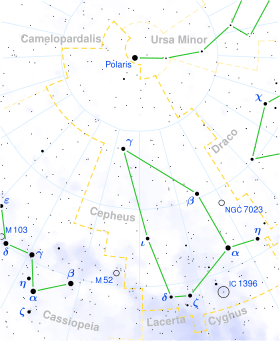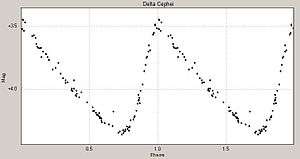Delta Cephei

| |
| Observation data Epoch J2000.0 Equinox J2000.0 | |
|---|---|
| Constellation | Cepheus |
| δ Cep A | |
| Right ascension | 22h 29m 10.26502s[1] |
| Declination | +58° 24′ 54.7139″[1] |
| Apparent magnitude (V) | 4.07 (3.48–4.37) / 7.5 |
| δ Cep C | |
| Right ascension | 22h 29m 09.248s[1] |
| Declination | +58° 24′ 14.76″[1] |
| Apparent magnitude (V) | 6.3 |
| Characteristics | |
| Spectral type | F5Ib-G1Ib[2] + B7-8[3] |
| U−B color index | 0.36 |
| B−V color index | 0.60 |
| Variable type | Cepheid |
| Astrometry | |
| Radial velocity (Rv) | -16.8[4] km/s |
| Proper motion (μ) | RA: +15.35[1] mas/yr Dec.: +3.52[1] mas/yr |
| Parallax (π) | 3.77 ± 0.16[1] mas |
| Distance | 887 ± 26 ly (272 ± 8[5][6] pc) |
| Absolute magnitude (MV) | –3.47 ± 0.10[7] |
| Details | |
| δ Cep A | |
| Mass | 4.5 ± 0.3[7] M☉ |
| Radius | 44.5[7] R☉ |
| Luminosity | ∼2000[7] L☉ |
| Temperature | 5,500–6,800 K |
| Metallicity [Fe/H] | +0.08[8] dex |
| Rotational velocity (v sin i) | 9[9] km/s |
| Age | ~100 Myr |
| δ Cep B[4] | |
| Mass | 0.2 - 1.2 M☉ |
| Orbit[4] | |
| Primary | δ Cep A |
| Companion | δ Cep B |
| Period (P) | 6.03 yr |
| Eccentricity (e) | 0.647 |
| Semi-amplitude (K1) (primary) | 1.509 ± 0.2 km/s |
| Other designations | |
| Database references | |
| SIMBAD | data |
Delta Cephei (δ Cep, δ Cephei) is the Bayer designation for a quadruple star system[4] located approximately 887 light-years away in the northern circumpolar constellation of Cepheus, the King. At this distance, the visual magnitude of the star is diminished by 0.23 as a result of extinction caused by gas and dust along the line of sight.[5] It is the prototype of the Cepheid variable stars that undergo periodic changes in luminosity.
Discovery
Delta Cephei was discovered to be variable by John Goodricke during 1784. He describes his first observation on October 19, 1784, followed by a regular series of observations most nights until December 28. Further observations were made during the first half of 1785, the variability was described in a letter dated June 28, 1785, and formally published on January 1, 1786.[10] This was the second variable star of this type, with eta Aquilae being discovered just a few weeks earlier on September 10, 1784.[11]
Properties
As well as being the prototype, Delta Cephei is among the closest stars of this type of variable to the Sun, with only Polaris being nearer. Its variability is caused by regular pulsation in the outer layers of the star. It varies from magnitude 3.48 to 4.37, and its stellar classification also varies, from about F5 to G3. The pulsation period is 5.366341 days, with a rise to maximum occurring quicker than the subsequent decline to minimum.[12]

Because the period of this class of variable is dependent on the star's luminosity, Delta Cephei is of particular importance as a calibrator for the period-luminosity relationship since its distance is now among the most precisely established for a Cepheid. This accuracy is thanks in part to its membership in a star cluster[6][13] and the availability of precise Hubble Space Telescope/Hipparcos parallaxes.[5] Hence, in 2002, the Hubble Space Telescope was used to determine the distance to Delta Cephei within a 4% margin of error: 273 parsecs (890 light-years) .[14] However, a re-analysis of Hipparcos data found a larger parallax than before, leading to a shorter distance of 244 ± 10 pc, which is equivalent to 800 light-years.[4]

Radial velocity measurements of Delta Cephei have revealed the presence of a small spectroscopic companion star on a 6 year orbit around Delta Cephei A.[4] The mass of this companion is about 10 times smaller than the mass of Delta Cephei and the two come to within 2 astronomical units at pericenter passage. The presence of this companion will have to be taken into account when Gaia measures Delta Cephei’s parallax (distance). The outer visual companion Delta Cephei C may also be a spectroscopic [15] and astrometric,[5] possibly rendering Delta Cephei a hierarchical quadruple system composed of two spectroscopic binaries.
Stars of this type are believed to form with masses of 3–12 times that of our Sun, and then have passed through the main sequence as B-type stars. With the hydrogen consumed in their core region, these unstable stars are now passing through later stages of nuclear burning.[16] The estimated mass of Delta Cephei, as derived from the color index, is 4.5 ± 0.3 times the mass of the Sun. By comparison, the mass derived from evolutionary models is 5.0 - 5.25 times the Sun's mass.[4] At this stage of its evolution, the outer layers of the star have expanded to an average of 44.5 times the girth of the Sun.[7]

Delta Cephei is emitting around 2,000 times the Sun’s luminosity from the outer atmosphere. This is producing a strong stellar wind, which, in combination with the pulsations and shocks in the star’s atmosphere,[17] is ejecting mass at the rate of (1.0 ± 0.8) × 10−6 solar masses per year, or the equivalent to the mass of the Sun roughly every million years. This matter is flowing outward at a velocity of about 35 km s−1. The result of this expelled gas is the formation of a nebula about 1 parsec across, centered on Delta Cephei, and containing 0.07–0.21 solar masses of neutral hydrogen.[7] A bow shock is being formed where the stellar wind is colliding with the surrounding interstellar medium.[18]
The peculiar velocity of Delta Cephei is 13.5 ± 2.9 km s−1 relative to its neighbors.[19] It is a suspected member of the Cep OB6 star cluster, and hence may be around the same age as the cluster: around 79 million years.[6] At an angular separation of 40 arc seconds from Delta Cephei is a 7.5 magnitude companion star with the identifier HD 213317, which is visible in small telescopes. This itself is a binary star system with a combined stellar classification of B7–8 III–IV. It is heating the matter being ejected by the stellar wind of Delta Cephei, causing the surrounding circumstellar material to emit infrared radiation.[18]
References
- 1 2 3 4 5 6 7 van Leeuwen, F. (November 2007), "Validation of the new Hipparcos reduction", Astronomy and Astrophysics 474 (2): 653–664, arXiv:0708.1752, Bibcode:2007A&A...474..653V, doi:10.1051/0004-6361:20078357.
- ↑ Engle, S. G.; Guinan, E. F.; Harper, G. M.; Neilson, H. R.; Evans, N. R. (2014). "THE SECRET LIVES OF CEPHEIDS: EVOLUTIONARY CHANGES AND PULSATION-INDUCED SHOCK HEATING IN THE PROTOTYPE CLASSICAL CEPHEID δ Cep". The Astrophysical Journal 794: 80. arXiv:1409.8628. Bibcode:2014ApJ...794...80E. doi:10.1088/0004-637X/794/1/80.
- ↑ Evans, Nancy Remage (2013). "BINARY CEPHEIDS: SEPARATIONS AND MASS RATIOS IN 5 M ☉ BINARIES". The Astronomical Journal 146 (4): 93. arXiv:1307.7123. Bibcode:2013AJ....146...93R. doi:10.1088/0004-6256/146/4/93.
- 1 2 3 4 5 6 7 Anderson, R.I. (May 2015), "Revealing δ Cephei's Secret Companion and Intriguing Past", The Astrophysical Journal 804: 144–155, arXiv:1503.04116, Bibcode:2015ApJ...804..144A, doi:10.1088/0004-637X/804/2/144.
- 1 2 3 4 Benedict, G. Fritz; et al. (2002), "Astrometry with the Hubble Space Telescope: A Parallax of the Fundamental Distance Calibrator δ Cephei", Astronomical Journal, arXiv:astro-ph/0206214, Bibcode:2002AJ....124.1695B, doi:10.1088/0004-637X/747/2/145.
- 1 2 3 Majaess, D.; Turner, D.; Gieren, W. (2012), "New Evidence Supporting Cluster Membership for the Keystone Calibrator Delta Cephei", Astrophysical Journal 747 (2): 145, arXiv:1201.0993, Bibcode:2012ApJ...747..145M, doi:10.1088/0004-637X/747/2/145.
- 1 2 3 4 5 6 Matthews, L. D.; et al. (January 2012), "New Evidence for Mass Loss from δ Cephei from H I 21 cm Line Observations", The Astrophysical Journal 744 (1): 53, arXiv:1112.0028, Bibcode:2012ApJ...744...53M, doi:10.1088/0004-637X/744/1/53.
- ↑ Groenewegen, M. A. T. (September 2008), "Baade-Wesselink distances and the effect of metallicity in classical cepheids", Astronomy and Astrophysics 488 (1): 25–35, arXiv:0807.1269, Bibcode:2008A&A...488...25G, doi:10.1051/0004-6361:200809859.
- ↑ Uesugi, Akira; Fukuda, Ichiro (1970), "Catalogue of rotational velocities of the stars", Contributions from the Institute of Astrophysics and Kwasan Observatory (University of Kyoto), Bibcode:1970crvs.book.....U.
- ↑ Goodricke, J.; Bayer (1786). "A Series of Observations on, and a Discovery of, the Period of the Variation of the Light of the Star Marked Formula by Bayer, Near the Head of Cepheus. In a Letter from John Goodricke, Esq. To Nevil Maskelyne, D. D. F. R. S. And Astronomer Royal". Philosophical Transactions of the Royal Society of London 76: 48. doi:10.1098/rstl.1786.0002.
- ↑ "Astronomers Celebrate Cepheid Bicentenary". Journal of the Royal Astronomical Society of Canada Newsletter 78: L76. December 1984. Bibcode:1984JRASC..78L..76P.
- ↑ Samus, N. N.; Durlevich, O. V.; et al. (April 2011), GCVS - General Catalog of Variable Stars, Institute of Astronomy of Russian Academy of Sciences and Sternberg, State Astronomical Institute of the Moscow State University, retrieved 2012-04-01. Note: search on 'del cep' after selecting the 'period' field.
- ↑ de Zeeuw, P. T.; et al. (1999), "A HIPPARCOS Census of the Nearby OB Associations", Astronomical Journal 117 (1): 354–399, arXiv:astro-ph/9809227, Bibcode:1999AJ....117..354D, doi:10.1086/300682.
- ↑ Benedict, G. Fritz; et al. (2002), "Astrometry with the Hubble Space Telescope: A Parallax of the Fundamental Distance Calibrator δ Cephei", The Astronomical Journal 124 (3): 1695–1705, arXiv:astro-ph/0206214, Bibcode:2002AJ....124.1695B, doi:10.1086/342014.
- ↑ Fernie, J.D. (1966), "Classical Cepheids with companions. I. Delta Cephei.", The Astronomical Journal 71: 119–122, Bibcode:1966AJ.....71..119F, doi:10.1086/109866
- ↑ Turner, David G. (1998), "Monitoring the Evolution of Cepheid Variables", The Journal of the American Association of Variable Star Observers 26: 101, Bibcode:1998JAVSO..26..101T.
- ↑ Neilson, Hilding R.; Lester, John B. (September 2008), "On the Enhancement of Mass Loss in Cepheids Due to Radial Pulsation", The Astrophysical Journal 684 (1): 569–587, arXiv:0803.4198, Bibcode:2008ApJ...684..569N, doi:10.1086/588650.
- 1 2 Remage Evans, Nancy; Marengo, M.; Barmby, P.; Matthews, L. D.; Bono, G.; Welch, D. L.; Romaniello, M.; Huelsman, D.; Su, K. Y. L.; Fazio, G. (May 2010), "Discovery Of An Infrared Bow Shock Associated With Delta Cephei", Bulletin of the American Astronomical Society 41: 839, Bibcode:2010AAS...21642601R.
- ↑ Tetzlaff, N.; Neuhäuser, R.; Hohle, M. M. (January 2011), "A catalogue of young runaway Hipparcos stars within 3 kpc from the Sun", Monthly Notices of the Royal Astronomical Society 410 (1): 190–200, arXiv:1007.4883, Bibcode:2011MNRAS.410..190T, doi:10.1111/j.1365-2966.2010.17434.x.
External links
- "Delta Cephei". American Association of Variable Star Observers. September 2000. Archived from the original on 2008-06-08. Retrieved 2008-06-21.
- "Delta Cephei". The Internet Encyclopedia of Science. Retrieved 2008-06-21.
| ||||||||||||||||||||||||||||||||||||||||||||||||||||||||||||||||||||||||||||||||||||||
Coordinates: ![]() 22h 29m 10.26502s, +58° 24′ 54.7139″
22h 29m 10.26502s, +58° 24′ 54.7139″